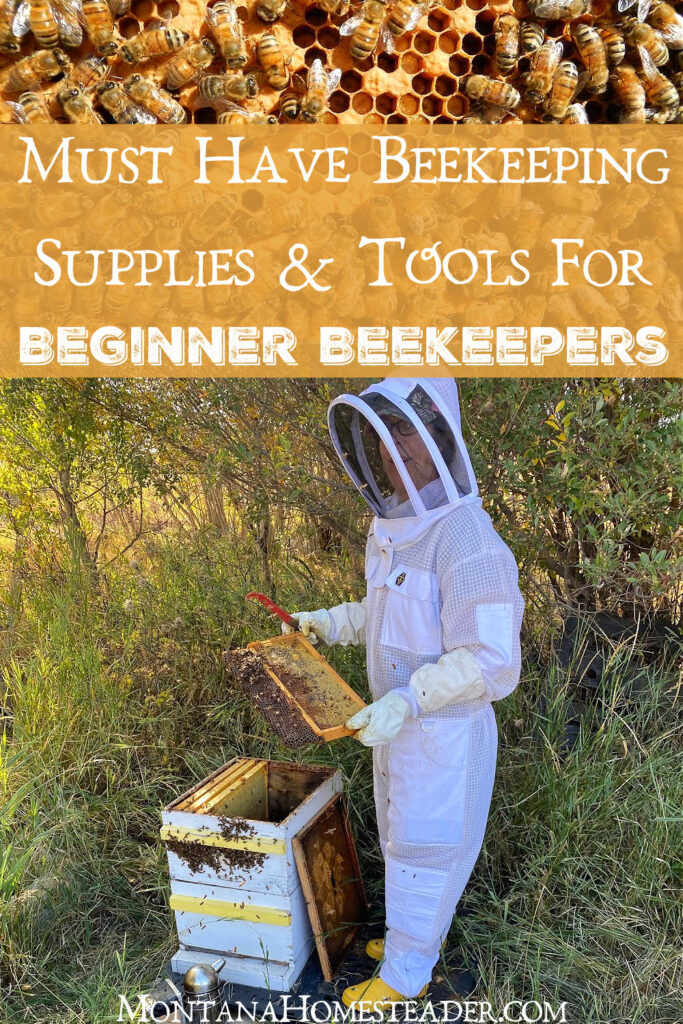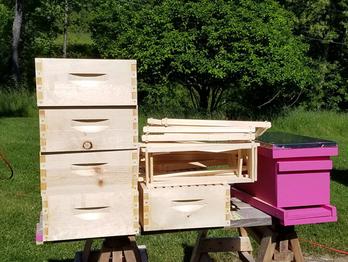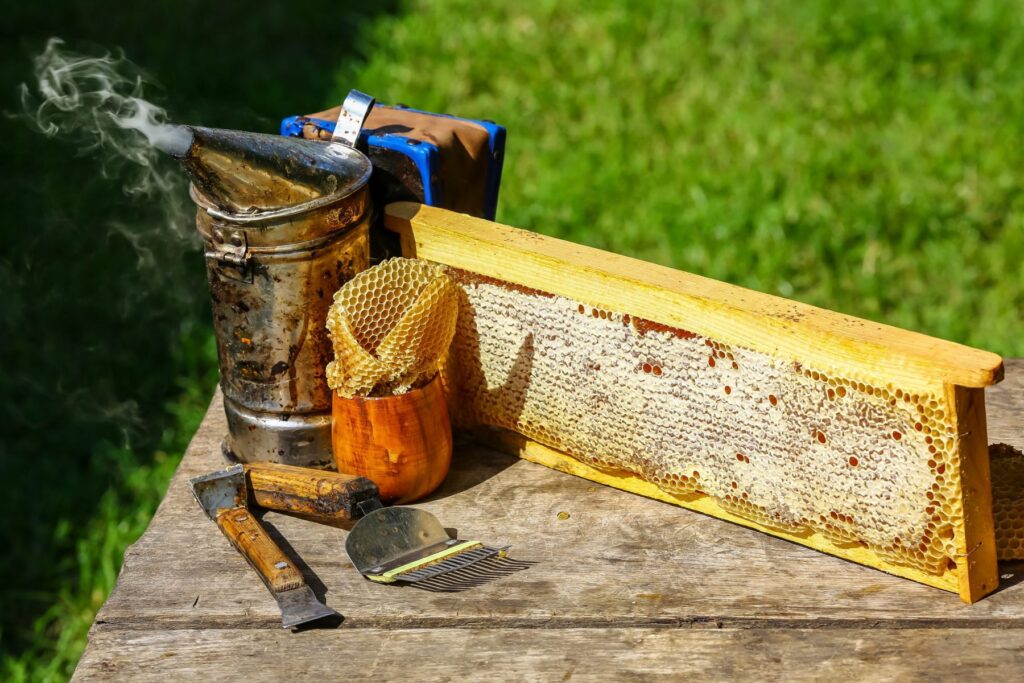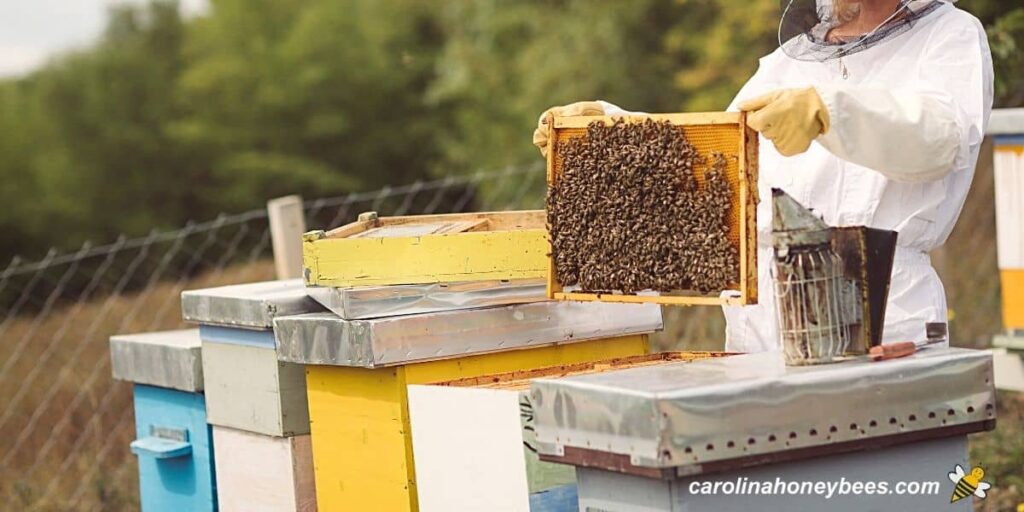
Imagine the joy of harvesting your own honey and watching your garden flourish with the help of hardworking bees. If you’ve always wanted to delve into the world of beekeeping but thought it was too expensive, think again! In this article, we will explore a range of affordable tools and techniques that are perfect for newbies looking to start their beekeeping journey on a budget. From cost-effective hive options to DIY equipment, you’ll discover how easy and affordable it can be to become a beekeeper. So, grab your protective gear and get ready to explore the world of beekeeping without breaking the bank!
1. Beekeeping Basics
1.1 Understanding the Importance of Beekeeping
Beekeeping is not just a hobby; it plays a vital role in our ecosystem. Bees are excellent pollinators, contributing to the reproduction of many plant species that provide food for both humans and animals. They play a crucial role in the production of fruits, vegetables, nuts, and seeds, making them essential for maintaining biodiversity and food security.
1.2 Benefits of Beekeeping on a Budget
Beekeeping is often seen as an expensive endeavor, but it doesn’t have to be. By adopting budget-friendly techniques and utilizing affordable tools, you can enjoy the many benefits of beekeeping without breaking the bank. Not only does beekeeping offer the opportunity to harvest delicious honey, but it also provides a deeper connection with nature and can be a source of relaxation and stress relief.
1.3 Common Challenges Faced by New Beekeepers
As a new beekeeper, you may encounter a few challenges along the way. It’s important to be aware of these common obstacles and learn how to overcome them. Some of the challenges faced by new beekeepers include managing swarms, dealing with pests and diseases, ensuring proper hive insulation for winter, and establishing a sustainable feeding routine. However, with the right knowledge and tools, you can overcome these challenges and become a successful beekeeper.
2. Essential Beekeeping Equipment
2.1 Protective Gear and Clothing
When starting beekeeping, investing in proper protective gear and clothing is crucial. This includes a beekeeping suit or jacket, gloves, and a veil to keep you safe from bee stings. Choose durable, comfortable gear that provides full coverage and minimizes the risk of injury while working with the bees.
2.2 Hive Components
A beekeeping hive consists of several essential components. These include the bottom board, hive body or box, frames, foundation, inner cover, and outer cover. These components work together to provide a safe and suitable habitat for the bees and allow for easy hive inspection and honey extraction.
2.3 Beekeeping Tools
There are several tools that every beekeeper should have in their arsenal. These include a hive tool, which is used to pry apart frames and boxes, a bee brush for gently removing bees from frames, a queen excluder to prevent the queen from entering certain areas of the hive, and a bee smoker, which helps to calm the bees during inspections.
2.4 Smokers and Fuel
A bee smoker is a crucial tool for beekeepers as it helps to calm the bees and make them more manageable during hive inspections. Smokers work by puffing cool smoke into the hive, which triggers a response from the bees to eat honey, making them less aggressive. Choose a durable smoker and stock up on fuel such as smoker pellets, wood chips, or pine needles.
2.5 Feeding Equipment
During certain periods, such as winter or when establishing a new hive, it may be necessary to supplement the bees’ food supply. Feeding equipment such as frame feeders or entrance feeders can be used to provide sugar syrup or pollen substitute to ensure the bees have enough food to survive and thrive.
2.6 Extracting Equipment
One of the most rewarding aspects of beekeeping is harvesting your own honey. To extract honey, you’ll need specialized equipment such as an extractor, uncapping knife or fork, and strainers or filters to remove impurities. Investing in good-quality extracting equipment will help you maximize your honey harvest and produce high-quality honey.

This image is property of montanahomesteader.com.
3. Homemade Beekeeping Tools
3.1 DIY Smoker
If you’re on a budget, consider making your own bee smoker instead of purchasing one. You can use a metal can or tin, drill holes into it for airflow, and attach a bellow or hand-operated air pump to produce smoke. Look for online tutorials or consult experienced beekeepers for guidance on constructing a homemade smoker.
3.2 Making Hive Components
Another way to save money is by making your own hive components. With some basic woodworking skills and the right tools, you can create hive bodies, frames, and other components at a fraction of the cost of buying them pre-made. Look for plans and templates online or join local beekeeping forums to connect with other DIY beekeepers who can share their knowledge and resources.
3.3 Creating Bee Feeders
Instead of purchasing ready-made bee feeders, you can create your own using inexpensive materials. For example, you can repurpose a mason jar by poking small holes in the lid and filling it with sugar syrup. Alternatively, you can use a plastic container with small holes drilled into the sides to allow the bees access to the food.
3.4 Homemade Uncapping Tools
When harvesting honey, you’ll need an uncapping tool to remove the wax cappings from the frames before extracting the honey. Instead of buying an expensive uncapping knife, you can repurpose a heated serrated knife or create a homemade uncapping fork using a stainless steel fork and bending the tines. These DIY alternatives work just as effectively and save you money.
4. Cost-Effective Hive Management Techniques
4.1 Swarm Prevention and Control
Swarming is a natural process in the life cycle of a bee colony, but it can result in the loss of bees and honey production. To prevent swarming, ensure your hive has sufficient space by adding extra supers or boxes when needed. Regular inspections and proper management of the hive’s brood chamber can also help prevent swarming.
4.2 Integrated Pest Management
Pests such as varroa mites and wax moths can pose a threat to bee colonies. Implementing integrated pest management (IPM) techniques can help control these pests without relying heavily on expensive chemical treatments. IPM strategies include regular monitoring, drone brood removal, and using non-toxic methods like powdered sugar dusting or screened bottom boards.
4.3 Natural Hive Insulation
Insulating your hives can help the bees maintain stable temperatures and reduce heat or cold stress. Instead of purchasing expensive insulation materials, consider using cost-effective alternatives such as straw or wood shavings. Placing these materials on top of the inner cover can provide insulation while also allowing for ventilation.
4.4 Sustainable Feeding Methods
Feeding bees can become costly, especially if using commercial feeders and supplements. Instead, explore sustainable feeding methods such as planting diverse flowering plants near the hives to provide a natural food source. Additionally, consider creating your own bee pollen substitute using a mixture of pollen, supplements, and sugar syrup.

This image is property of i.ytimg.com.
5. Seasonal Beekeeping on a Budget
5.1 Spring Preparation and Maintenance
Spring is a crucial time for beekeepers to prepare their hives for the coming season. Conduct thorough inspections to assess the colony’s health, check for signs of disease or pests, and ensure adequate food stores. Budget-friendly techniques for hive maintenance include reusing old frames by replacing the foundation or repairing damaged equipment instead of buying new ones.
5.2 Summer Hive Management
During the summer months, the hive population peaks, and honey production is at its highest. Regular inspections are essential to monitor the colony’s health, check for signs of swarming, and ensure sufficient honey supers are added as needed. Taking preventive measures to control pests and diseases can help avoid costly treatments later on.
5.3 Fall Harvest Strategies
Fall is the time when beekeepers reap the rewards of their efforts. Proper timing and techniques for honey harvesting can help maximize yields and minimize stress on the colony. Budget-friendly methods include using homemade honey extraction equipment, such as a simple crush-and-strain method, which requires minimal equipment and is suitable for small-scale beekeepers.
5.4 Winterizing the Hive
Winter poses unique challenges for beekeepers, as the bees must stay warm and have sufficient food stores to survive until spring. To prepare for winter, ensure the hive is properly insulated, reducing the risk of heat loss. Implementing cost-effective methods, such as using burlap or bubble wrap to wrap the hive, can provide insulation at a fraction of the cost of commercial insulating materials.
6. Sustainable Beekeeping Practices
6.1 Local Queen and Bee Sources
When expanding your apiary or replacing queens, consider sourcing bees and queens locally. Local bees are often better adapted to the area’s climate and conditions, reducing the risk of introducing non-native species or weak genetics. Local suppliers or beekeeping associations may offer cost-effective options for purchasing bees or queen cells.
6.2 Organic Beekeeping Practices
Organic beekeeping focuses on maintaining the health and well-being of the bees through natural practices. By avoiding the use of synthetic chemicals and antibiotics, organic beekeepers promote a sustainable and environmentally friendly approach. Implementing organic practices, such as using organic treatments for pests and diseases and providing forage from pesticide-free sources, can contribute to the overall health of your bees.
6.3 Regenerative Beekeeping Methods
Regenerative beekeeping goes beyond traditional beekeeping practices by emphasizing the restoration of natural habitats and biodiversity. By promoting the growth of native plants and creating bee-friendly landscapes, regenerative beekeepers support pollinator populations and contribute to the conservation of ecosystems. Adopting regenerative techniques can enhance the sustainability of your beekeeping operation and benefit the environment.

This image is property of www.beekeepingfornewbies.com.
7. Community and Cooperative Beekeeping
7.1 Sharing Resources and Knowledge
Beekeeping is a communal activity, and joining or establishing local beekeeping groups can provide numerous benefits for budget-conscious beekeepers. These groups often facilitate the exchange of knowledge, resources, and equipment among members. By participating in a supportive community, beekeepers can learn from experienced individuals and access cost-saving opportunities through shared resources.
7.2 Mentorship Programs
Mentorship programs connect new beekeepers with seasoned mentors who can provide guidance and support. Mentors can offer valuable advice on various aspects of beekeeping, including cost-effective techniques and tools. Seek out local beekeeping associations or online platforms that offer mentorship programs to tap into this valuable resource.
7.3 Group Purchasing and Bulk Discounts
Pooling resources with other beekeepers can lead to significant cost savings. By organizing group purchases of equipment, supplies, or bees, you can take advantage of bulk discounts and lower shipping costs. Collaborating with fellow beekeepers also allows for the shared use of specialized equipment, reducing individual expenses.
7.4 Establishing Beekeeping Associations
If there isn’t an existing beekeeping association in your area, consider establishing one. Beekeeping associations provide a platform for beekeepers to share knowledge, experiences, and resources. By coming together as a community, members can negotiate better deals with suppliers, organize educational workshops, and advocate for policies that support sustainable beekeeping practices.
8. Beekeeping Education on a Budget
8.1 Online Resources and Courses
The internet offers a wealth of information and educational resources for aspiring beekeepers. Numerous websites, blogs, and forums provide free or low-cost resources, including articles, videos, and webinars. Online courses and workshops are another affordable option for comprehensive beekeeping education and can be accessed from the comfort of your own home.
8.2 Local Beekeeping Workshops and Seminars
Many local beekeeping associations and agricultural organizations host workshops and seminars throughout the year. These events often feature experienced beekeepers and industry experts who share their knowledge and offer practical demonstrations. Attending these workshops can provide valuable insights and hands-on learning opportunities without a significant financial investment.
8.3 Public Library Beekeeping Materials
Public libraries are an excellent resource for beekeeping literature. Many libraries offer books, magazines, and DVDs related to beekeeping, providing access to a wealth of information at no cost. Borrowing beekeeping materials from the library allows you to learn from experienced authors and experts while saving money on purchasing books.

This image is property of ogden_images.s3.amazonaws.com.
9. Budget-Friendly Beehive Locations
9.1 Choosing the Right Hive Location
Selecting an appropriate location for your beehive is essential for the well-being of your bees and the success of your beekeeping venture. Consider factors such as ample sunlight, protection from wind, and accessibility for hive inspections. Utilize your own property or seek permission from friends or local businesses to utilize their land for hive placement, reducing or eliminating the need for rental or purchasing costs.
9.2 Utilizing Small Spaces for Beekeeping
Beekeeping is not limited to expansive rural areas; it can be practiced in small spaces too. Urban beekeeping has gained popularity in recent years, with many beekeepers successfully maintaining hives on rooftops, balconies, or even small gardens. Utilize vertical space by setting up multiple hives on sturdy shelves or stands, making the most of limited areas.
9.3 Rooftop and Urban Beekeeping
Rooftop beekeeping offers several advantages, including reduced exposure to pesticide-laden environments and a diverse range of nectar sources in urban settings. If you live in an apartment or have access to a rooftop, consider this option for your beekeeping adventure. Ensure you follow local regulations and guidelines for urban beekeeping and implement proper safety measures to avoid any disruptions or issues.
10. Cost-Saving Beekeeping Tips
10.1 Buying in Bulk and Shared Orders
Purchasing beekeeping supplies in bulk or coordinating shared orders with other beekeepers can significantly reduce costs. By buying in larger quantities, you can take advantage of volume discounts and avoid frequent shipping charges. Additionally, group orders allow for the sharing of shipping costs, making it a more cost-effective option for everyone involved.
10.2 Repurposing and Upcycling
Beekeeping often presents opportunities for repurposing materials and equipment. For example, you can use old buckets or containers for feeding bees or create hive stands using recycled pallets. Tap into your creativity and resourcefulness to find unique ways of repurposing everyday items into functional beekeeping tools, saving money in the process.
10.3 Bartering and Trading with Beekeepers
Beekeeping communities are known for their willingness to help fellow beekeepers. Consider bartering or trading with other beekeepers for equipment, bees, or honey. For example, if you have surplus honey, you can exchange it for needed equipment or supplies. Building relationships with other beekeepers allows for mutually beneficial exchanges and fosters a sense of camaraderie within the beekeeping community.
10.4 DIY Honey Extraction
Commercial honey extractors can be costly, but with some creativity and basic tools, you can build your own honey extractor. Options range from simple hand-cranked models to more elaborate designs using power tools. Online resources and instructional videos provide step-by-step instructions on constructing DIY honey extractors, allowing you to enjoy the satisfaction of harvesting honey without the hefty price tag.
In conclusion, beekeeping on a budget is both achievable and rewarding. By adopting cost-saving techniques and utilizing affordable tools, you can embark on a fulfilling beekeeping journey without breaking the bank. Whether you choose to make your own equipment, implement sustainable practices, or join a supportive community, the opportunities for budget-friendly beekeeping are abundant. Embrace the adventure, connect with nature, and enjoy the sweet rewards of beekeeping on a budget.

This image is property of carolinahoneybees.com.